Oton Iveković
Oton Iveković (17 April 1869 – 4 July 1939) was a Croatian painter. A graduate of Academy of Fine Arts in Vienna, Iveković later taught at the Zagreb Academy of Fine Arts. He largely concerned himself with historical topics as well as some religious themes. Many of his paintings remain the chief representations of Croatian history.
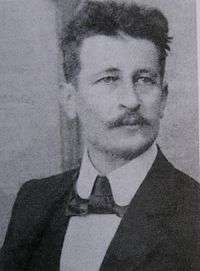
Biography
Early years
Oton Iveković was born on 17 April 1869 in Klanjec, where he finished elementary school. He attended high school for three and a half years in Zagreb where, except for History and Art, he neglected other subjects. In 1886, when his brother Cyril went to school in Vienna, Oton wanted to enter the Art Academy there. His family couldn't afford it, so he began his studies with Ferdo Quiquerez, a painter of French descent, in Zagreb. He didn't abandon his plans, however, and earned enough money through the autumn and winter to go to Vienna in the spring.
At the Academy
When he arrived in Vienna he took a summer semester as a guest student. In mid-1888 Oton became a regular student. Until 1890. he studied with Christian Griepenkerl. After that, he decided to specialize in history painting and studied with Josef Matyáš Trenkwald. At the request of his teacher, he was removed from the summer semester because of frequent arguments with other professors at the Academy. The next year he resumed his specialization in history painting, this time with August Eisenmenger. Later, Oton received a scholarship from the Academy and the Provincial Government in Zagreb. At the urging of Izidor Kršnjavi, and with his financial support, Iveković continued his studies at the Academy of Fine Arts, Munich. Encouraging Oton's history painting, Kršnjavi recommended Iveković to his friend, Ferdinand Keller at the Academy of Fine Arts, Karlsruhe.
Return to Croatia
After completing his specialization, Iveković returned to Croatia where he was immediately appointed professor of painting in a high school. The following year he was a teacher at the School of Crafts, which paid his basic living expenses. Iveković's most productive period lasted from 1894 to 1900, although his intensive activity did not stop even after 1900. At the beginning of the new century, his painting were shown at the World Exhibition in Paris.
In 1901, Iveković and Mato Celestin Medović worked on the illustrations for the epic poem Judita by Marko Marulić. In addition, Iveković illustrated August Šenoa's novel Zlatarevo Zlato (Goldsmiths's Gold), and was an active participant in the Matica hrvatska as a graphic designer. In 1903 he painted the founders of the Matica on a large canvas which may still be seen at the Matica's headquarters in Zagreb. He also worked in theater as a costume and set designer and, in 1904, was involved in the creation of the artistic association "Lada".
Visit to America
In 1908 The School of Crafts transformed into an art academy, where Iveković taught drawing and painting until his retirement in 1927. In 1910 he went to America to work on the Croatian parish of St. John the Baptist Roman Catholic Church in Kansas City, KS, where he painted ceilings and walls with fifteen various scenes. Upon completion of the job, he traveled through the American West, recording scenes from the life of cowboys and Indians. He published an account of his travels in 1911. In that same year he withdrew from the Croatian People's Peasant Party, where he had been one of the founding members.
The War
After the outbreak of the First World War Iveković went to the front as a war correspondent. From June 1915 to September 1918, he was at the battlefields in Sochi, Galicia and Serbia, recording scenes from military life.
After the war, he sold his house in Jurjevska street in Zagreb and bought the castle of Veliki Tabor. The castle was in very poor condition and required several master craftsmen to do the repair work. The Iveković family lived in Veliki Tabor until 1935. The castle was sold in 1938. Oton spent the last year of his life with his brother Albin in Klanjec.
Iveković died on 4 July 1939 in Klanjec.
Paintings
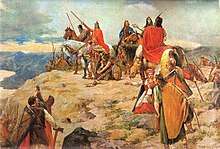 Arrival of Croats to the Adriatic Sea
Arrival of Croats to the Adriatic Sea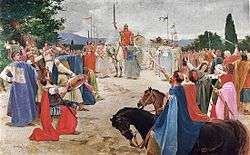 Coronation of King Tomislav
Coronation of King Tomislav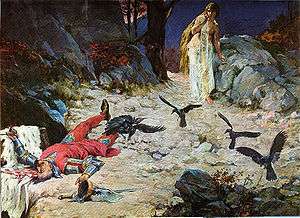 Death of King Petar Svačić
Death of King Petar Svačić.jpg) Execution of Matija Gubec
Execution of Matija Gubec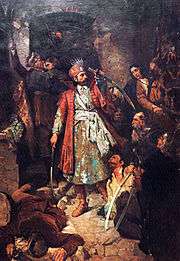 Nikola Šubić Zrinski
Nikola Šubić Zrinski.jpg) Massacre of Rakovica (Death of Eugen Kvaternik)
Massacre of Rakovica (Death of Eugen Kvaternik)
References
Sources
- Iveković, Oton at lzmk.hr (in Croatian)
External links
![]()